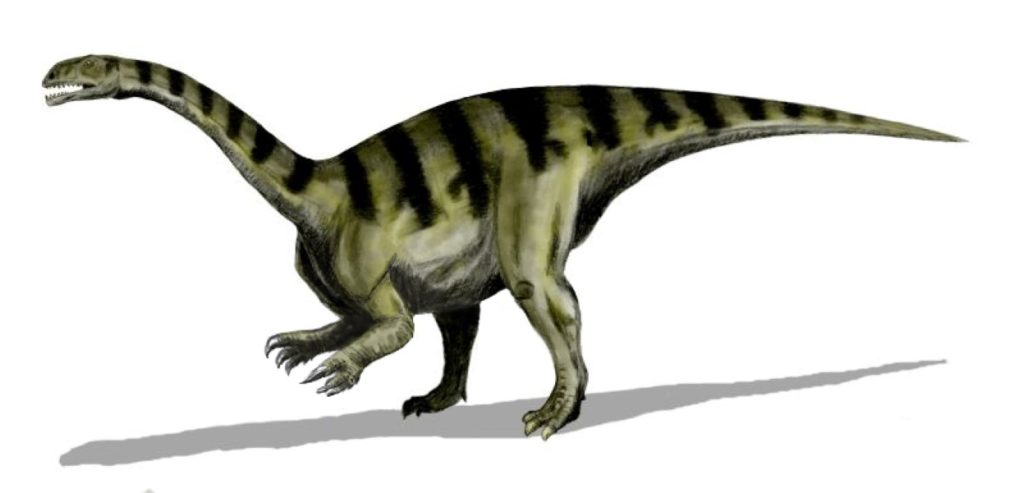A paper authored by Mario Bronzanti, Oliver Rauhut, Jonathas Bittencourt, and Max Langer in September of this year traced the evolution of the brain in the largest animals to ever walk the planet—the sauropods. The authors studied a braincase from Saturnalia tupiniquim, an ancestral form of sauropod called a sauropodomorph. By studying Saturnalia, they could observe how a certain lobe of the brain changed from one of the oldest (~230 million years old) true dinosaurs ever recovered. This lineage of dinosaur led to the largest group of herbivores to ever walk the planet.
Digital paleoneurology is a relatively new field of paleontology that uses computed tomography (CT) scans to show details of the inside of fossils by looking at negative spaces. Negative spaces are produced when, during decomposition, the soft tissues of the brain are replaced with sediment that surrounds the braincase. These sediments are less dense than the fossilized bone and are easily separated from the braincase. A CT scanner was used to image the less dense area of the skull where the brain was located during life. A digital reproduction of the brain of the dinosaur is made with the scans produced from the CT scanner. The digital reconstruction is a visual representation of what the inside of the braincase would have looked prior to death.
The scientists identified changes in a section of the brain that controlled the eyes, neck, and head movements – called the flocculus – by looking at the “negative space” left behind during the fossilization process. Much like modern animals, the flocculus of Saturnalia was located near the base of the brain and was threaded through the semicircular canals (the portion of the inner ear that interprets the movement of the head in three-dimensions) on the left and right sides of the brain. By having a floccular lobe that extends into the semicircular canals, paleontologists can infer that Saturnalia had a well-developed sense of balance and had a stabilized gaze that was more akin to omnivores or predators.
When compared to later, more evolved sauropodomorphs and sauropods, Saturnalia has a larger flocculus which extends further into the semicircular canal complex than it does in later sauropod forms. However, Saturnalia has a flocculus of smaller volume when compared to earlier dinosaurs, thus giving the earliest evidence of floccular reduction in the sauropod family tree. The volumetric reduction of the floccular lobes in more evolved sauropods is an indicator of a lessening of visual acuity and a general loss of agility – hallmarks of herbivores that do not need to track and run after prey. Saturnalia is the earliest known transition towards the gigantic, quadrupedal sauropods (e.g. Brachiosaurus and Apatosaurus) that are popularized in movies and social media.
So, what are the implications of larger flocculus lobes in Saturnalia and why are they important? Bronzanti et al. propose that the reduction of the floccular lobes show modifications that occurred due to a shift towards a herbivorous diet. Saturnalia is characterized as being bipedal and having a shorter neck than its larger cousins. These character traits are more associated with a predatory or omnivorous diet, lending to the hypothesis that Saturnalia falls into those dietary habits. This hypothesis is further supported when the scientists compared the teeth of Saturnalia to those of another Triassic sauropodomorph, Plateosaurus. Plateosaurus, much like Saturnalia, was a small bipedal sauropodomorph but differed in that the ridges along the teeth, called denticles, and width of the tooth crowns were coarser and larger, respectively, than those in Saturnalia. Coarser denticles are generally indicative of grinding surfaces in dinosaurs and are used to chew plant material instead of slicing through muscle tissue. Saturnalia had teeth that were curved and had smaller denticles that favored the serrations of omnivores and carnivores. This is a far cry from the straight, coarse, and tiny teeth found in the enormous sauropods of the Late Cretaceous (65 million years ago).
Saturnalia is the best view into the evolution of a dinosaur’s floccular lobe. By proxy, Saturnalia gives us an unprecedented view into how an organism’s brain changed as its locomotion and diet evolved through time. Digital palaeontology through CT scanning is currently one of the most active fields of vertebrate palaeontology – this paper is a great example of what it has to teach us about palaeobiology!


